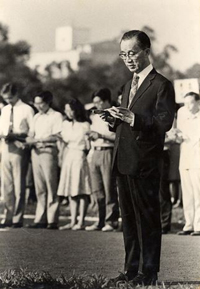 President Yu at the NTU Sports Field during a flag-raising ceremony in 1981. This is allegedly the former president’s favorite portrait of himself.
(Photo: Gallery of NTU History) The faculty, staff, and students of National Taiwan University has lost a legend and greatly loved icon as former NTU President Chao-Chung Yu (虞兆中) passed away at the age of 100 on May 12, 2014. A memorial was held at NTU in his honor on June 18, where the former president’s family, friends, and students gathered to celebrate his life, his legacy, and his passion and contributions to the nation’s educational system.
Yu served as president of NTU between 1981 to 1984. Before heading the university, he was a professor at the Department Civil Engineering, where he also served as department chairman, and was later appointed Dean of the College of Engineering.
President Yu is known for his hearty personality as well as his insistence on treating all around him as his family. While each speaker at the service, some his peers and others his students, shared their different memories of the late president, what they all had in common was the privilege of receiving the friendship that he generously extended to them, despite his status as president of the most established university in Taiwan.
During his residency, President Yu launched the project to reorganize the NTU Hospital, delineated plans for the establishment of the College of Management, and laid out a future blueprint for the development of the NTU campus. He was also responsible for establishing the university emblem, which be believed served as a symbol of our school as well as a reminder of the NTU motto of "Integrity, Diligence, Fidelity, and Compassion."
President Yu was also a leader of great vision. While he insisted on maintaining academic freedom and neutrality in the university, he also led NTU to becoming the first higher education institute in Taiwan to establish a general curriculum so that students would be equipped with a comprehensive training across the fields. NTU’s promotion of the curriculum later became the prototype for the Ministry of Education’s General Education program, which was followed by other universities across the island.
|

